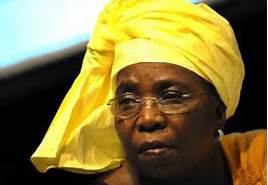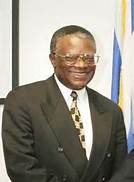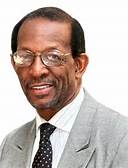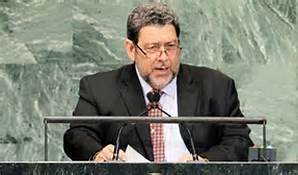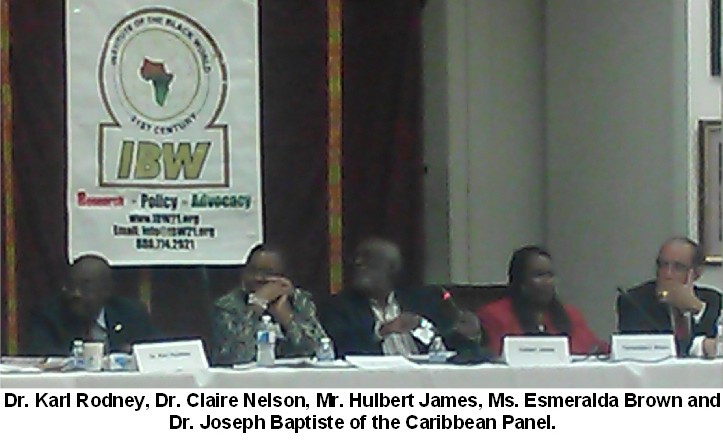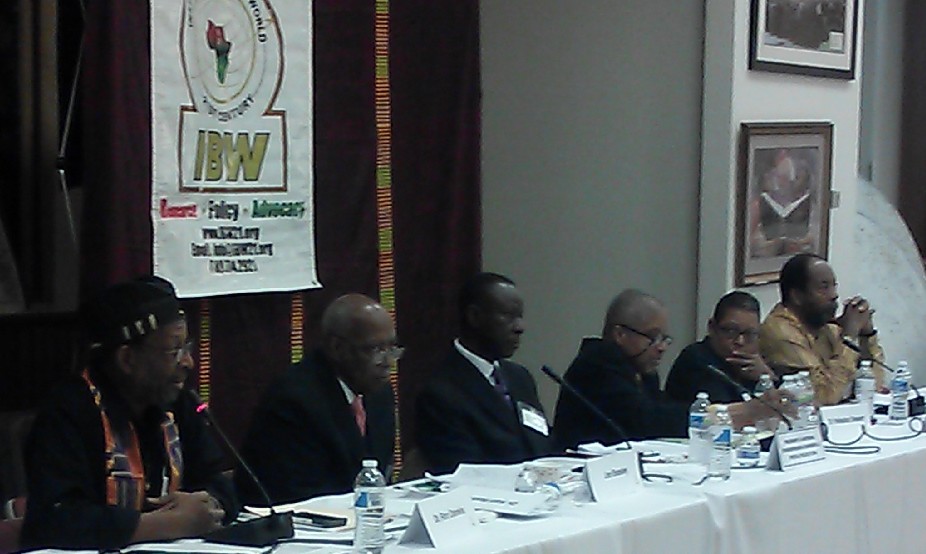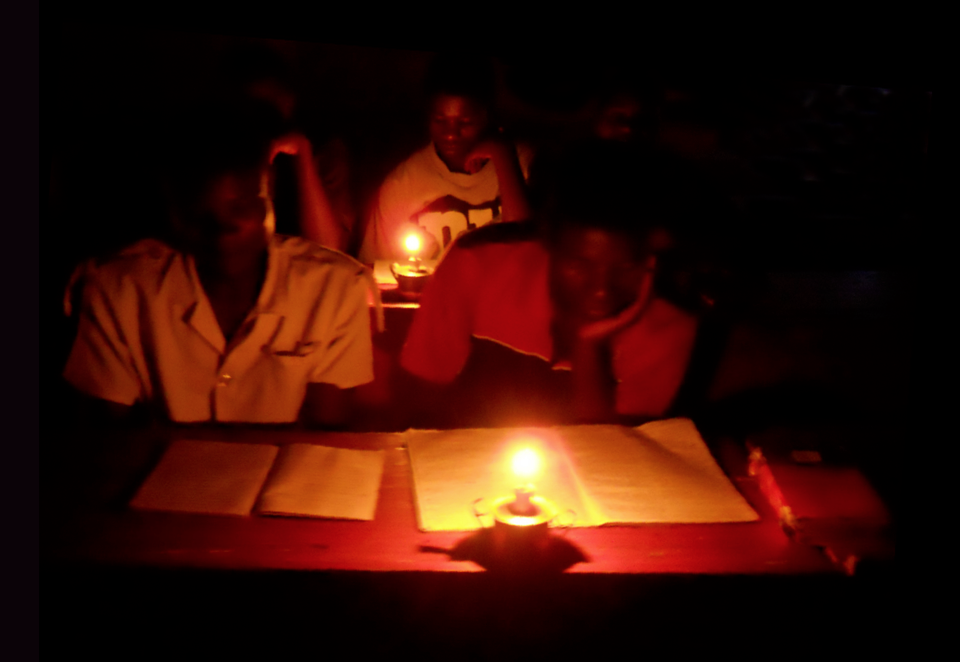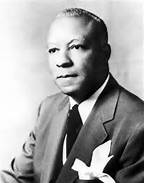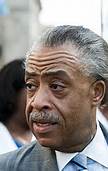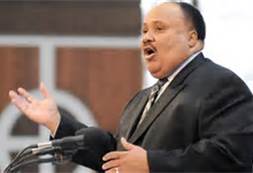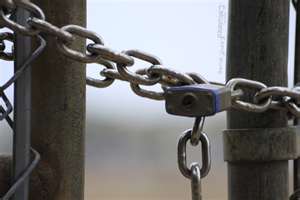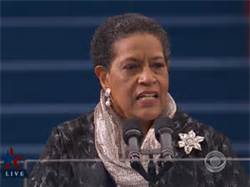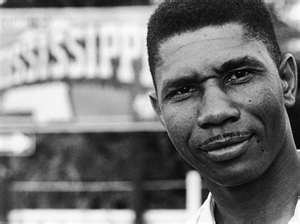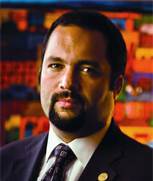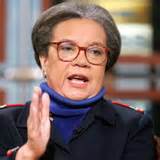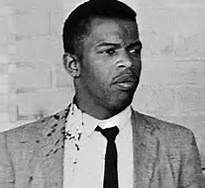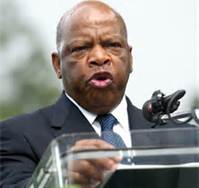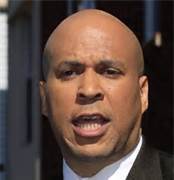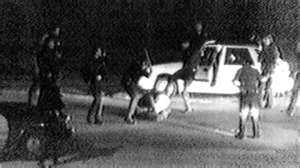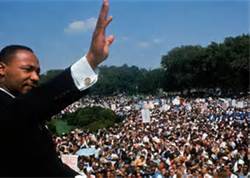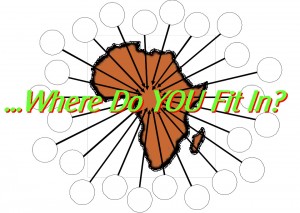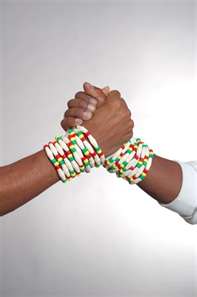April 18, 2014
For KUUMBAReport Online, https://kuumbareport.com
April 24, 2014 is the 60th birthday (Earth Day) of longtime Political Prisoner Mumia Abu-Jamal, and April 25th is the 68th birthday (Earth Day) of recently-released Political Prisoner Marshall “Eddie” Conway. These two Veterans of the Black Panther Party, both wrongly-convicted of murdering police officers, both pillars of the Pan-Afrikan Community and strong voices for truth and justice, are linked also by sharing a birth week as well as supporters in common within the Pan-Afrikan and Truth-And-Justice communities. We hope to report on the events in Philadelphia, Pennsylvania commemorating Mumia’s 60th Earth Day. Below, in celebration of Eddie’s 68th Earth Day and of his newfound freedom, we offer this brief look at his case and at some of those who contributed, in ways large and small, to his ultimate liberation.
Pan-Afrikan and human rights activists have estimated that between 150 and 200 people are currently being held in state prisons, jails and federal penitentiaries across the United States because of their political activism, despite the repeated claims of US officials that this country holds no one for political reasons. These estimated 150 to 200 people, members of organizations such as the American Indian Movement (AIM), the Black Panther Party (BPP) and its “underground” affiliate the Black Liberation Army (BLA), largely-White leftist organizations such as Students for a Democratic Society (SDS) and its “underground” affiliate the Weather Underground, the Puerto Rican Independentista activists, various Socialist groups, the MOVE Organization and others, are considered by activists in the Pan-Afrikan, Black Nationalist and leftist communities to be Political Prisoners (PPs) or Prisoners of War (POWs).
Political Prisoners are those, such as community activists in the BPP, AIM and SDS, for example, whose work dealt with the organizing of repressed communities in the area of political activism, while Prisoners of War are those who have concluded, based on the frequent murderous attacks by police on members of the BPP, AIM, SDS and various non-violent activists, that a full-blown state of war existed between these communities and the government of the United States, and thus had dedicated themselves to the waging of armed resistance, many under the banners of the BLA and Weather Underground, respectively.
Since the United States could not officially imprison someone because of their political beliefs since the tactics of Sen. Joe McCarthy and the “Red Scare” of the 1920’s to the 1950’s were discredited, another means had to be developed to remove these activists from the populace. Thus, with the collusion of corrupt police and judges and the compliance of a cooperative media, the easily gullible populace would be persuaded that these activists posed a mortal threat to the average, law-abiding American citizen. Three primary tactics were instituted.
First, the Federal Bureau of Investigation (FBI) made official public announcements designating organizations such as the BPP to be “the greatest threat to the internal security of the United States”, while issuing internal memoranda detailing its plan to “destabilize, disrupt and neutralize” the BPP and AIM in particular but also Civil Rights leaders such as the Rev. Martin Luther King Jr., Medgar Evers and Malcolm X. This plan actually included the infiltration of these organizations with “agents” or “provocateurs” who would spy on members for their FBI “handlers”, attempt to persuade organizational leaders to undertake illegal and violent actions in the name of “the struggle” (the vast majority of these “suggestions” were rejected because of their violence and illegality), and even attempt to “finger” loyal members as traitors to get them to turn on each other. Several activists were killed by their own people during the 1960s and 1970s because they were believed to have been traitors based on the accusations of members who themselves turned out to be the “agents”.
Second was a wave of official “extra-judicial” violence directed against Civil Rights and community activists. Rev. Dr. Martin Luther King Jr. was surveilled, terrorized and finally shot on a hotel balcony by a supposed racist vigilante, though the surveillance and terror tactics had been committed by the FBI and police. Medgar Evers was shot in the back in his driveway. Malcolm X was surveilled and terrorized by the FBI, firebombed and finally shot to death at a public meeting. Members of the Black Panther Party, officially founded in California’s Bay Area in 1966 but inspired by the Lowndes County (Louisiana) Community Organization, were also spied upon, infiltrated, and murdered in police raids. Prime examples of this tactic included Bobby Hutton (Los Angeles, 1968) and Fred Hampton Sr. (Chicago, 1969).
The third tactic can be examined today, in the names and faces of the activists of the BPP, MOVE and AIM in particular who were targeted, arrested and subjected to “kangaroo court”-style trials, complete with questionable “jailhouse” informants, inflammatory politically-motivated rhetoric (the stereotype of the BPP as a “terrorist group” or of MOVE as “violent”), misconduct by police, prosecutors and judges, and most importantly, a lack of physical evidence (or the withholding of evidence that would exonerate the defendants). These trials were designed to convince a jury, in spite of a lack of evidence, to convict them and impose harsh sentences, ranging from life (Sundiata Acoli) to double-life (AIM’s Leonard Peltier) to terms up to 100 years (the MOVE Nine) to the death penalty (former Panther and MOVE supporter Mumia Abu-Jamal). The activists who were subjected to this tactic of public character assassination leading to unjust convictions on trumped-up charges are today’s Political Prisoners.
Among the longest-held Political Prisoners are Romaine “Chip” Fitzgerald (44 years in California), perhaps the longest-held of all, and Wopashitwe Mondo Eyen we Langa (42 years in Omaha, Nebraska). Another case of special note is that of veteran Panther Veronza Bowers (Florida), whose mandatory release date (you read that right) was eight years ago, but he remains in custody because of intercession from the law enforcement community over the objections of the prison warden, despite his acknowledged peaceful nature (he helped quell a prison riot that probably saved several correctional officers’ lives) and the usual issues of evidence and misconduct in his original case.
In March of 1998, the Jericho Organization took on greater prominence as the Jericho March for Political Prisoners marked a new phase in the effort to bring public awareness to this issue. Led by former Political Prisoner and now-Honored Ancestor Safiya Bukhari (she died of cancer at the age of just 53 in 2003), the Jericho ’98 March brought thousands of activists to Washington, D.C. to protest this country’s treatment of its Political Prisoners and Prisoners of War, most of whom were subjected to various forms of solitary confinement, sensory deprivation and other conditions that are considered torture by international human rights organizations. Though then-President Bill Clinton was conveniently in Afrika at the time, the march helped to galvanize a number of Political Prisoners’ support committees across the country.
One of the longest-held Political Prisoners was an important member of the Baltimore Chapter of the Black Panther Party and was considered part of the BPP’s “secondary leadership”. That fact, and the fact that he had helped uncover the existence of police spies in the Baltimore organization, caused him to become a prime target for neutralization by corrupt elements within the FBI, National Security Agency (NSA) and Baltimore City Police Red Squad. This veteran Panther, who was finally released from prison on March 4, 2014 after 43 years and 11 months of unjust imprisonment, is a man we in the Baltimore area all simply called “Eddie” but who is more widely known in activist circles as Marshall “Eddie” Conway.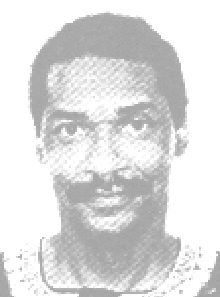
Convicted in 1970 (with absolutely no physical evidence) of the murder of a Baltimore City police officer, he had seen multiple parole petitions denied due to an Executive Order from Governor Parris Glendening forbidding parole for inmates serving life sentences, or “lifers”. This was brought about by a 1993 case in which a paroled lifer committed a murder after being released from prison. As a result, the Governor held his “Life Means Life” press conference outside the Maryland House of Correction in Jessup, Maryland, effectively ending all petitions for parole from lifers from that moment on. In the meantime, Eddie was a model prisoner, his record infraction-free for at least twenty years. He was a beacon of stability, earning several college degrees, mentoring younger inmates and establishing computer literacy and other educational programs for inmates during his over four decades behind bars. Thus, he embodied perhaps the best example of a prison-wide rehabilitation program, having single-handedly done more for many of the inmates than the official “rehabilitation” programs could have hoped to accomplish.
Over the years, Eddie’s lawyers filed multiple federal habeas corpus briefs to the federal courts, essentially pointing out that, without physical evidence to link him to the crime and only the use of a peculiar “stacked-deck” procedure (A police officer looked at two stacks of photographs with pictures of Eddie in both stacks to elicit a positive identification) and the testimony of a “jailhouse informer” who claims Eddie confessed to the murder of a Baltimore City police officer in 1969 to connect him to the crime, the state had failed to prove Eddie’s guilt. For his part, Eddie proclaimed his innocence from the start and insisted upon proving his innocence to the world.
Community Support for Marshall “Eddie” Conway
Before going into our list of contributors to Eddie’s struggle for freedom, we must state that we cannot possibly name everyone who had a hand in the effort on Eddie’s behalf. Eddie himself has suggested that we simply relay his thanks to all who played a part in his struggle. There are a number of people, however, who do deserve mention, and we have attempted to list them as completely as possible below. We will certainly forget someone, and we encourage our readers to mention these people in comments on this article. But we realize that we will almost certainly leave someone out, and we apologize in advance and we hope that no one will be offended by the oversight. That having been said, here goes.
Much of the public credit for Eddie’s successful release has gone to Attorneys Robert Boyle and Phillip G. Dantes. Attorney Boyle has been Eddie’s longtime legal counsel and has accompanied Eddie to his most recent public appearances to speak on the legal aspects of the case. They were the legal team who brought Eddie down the Home Stretch and across the Finish Line to his freedom. Earlier valuable legal support had also come from Attorney Edythe “Mama E.J” Jones, who spoke eloquently about Eddie’s case several times in the 1990’s and early 2000’s. This struggle was certainly not a sprint, though; it was a nearly 44-year marathon for justice, and the final victory was the result not only of their strong efforts but also of a decades-long, hard-fought campaign to raise public awareness and to undo the miscarriage of justice that was the original 1970 trial. In truth, the list of contributors, in ways both large and small, is quite long, and in this short article we can only hope to make mention of some of the many activists and organizations that had a hand in the decades-long struggle to free Marshall “Eddie” Conway.
 Two of the most active organizations in the struggle to free Eddie Conway, at least from the 1980s through the early 2000s, were the Marshall E. Conway Support Committee and the Friends of Eddie Conway, both of which were operated and staffed by Veterans of the Black Panther Party who either lived in Baltimore at the time of Eddie’s arrest or were living there as the work to free him became more organized. Some key members of these organizations who deserve special mention for their tireless and often thankless efforts include Nana Njinga Ohema Nyamekye, Baba Dessalines Kambon, Baba Yusef Bey, Sis. Ameejill Whitlock, Baba Gerald Mills, Dr. Gossie Harold-Hudson and Sis. Nzinga of WEAA-FM’s Just You & Me program, and Dr. Kwame SabakhuRa (who became an Honored Ancestor in 2000). More recently, the Partnership for Social Justice had managed Baba Eddie’s public outreach through the efforts of Sis. Dominique Stevenson and affiliates from the American Friends Service Committee (AFSC).
Two of the most active organizations in the struggle to free Eddie Conway, at least from the 1980s through the early 2000s, were the Marshall E. Conway Support Committee and the Friends of Eddie Conway, both of which were operated and staffed by Veterans of the Black Panther Party who either lived in Baltimore at the time of Eddie’s arrest or were living there as the work to free him became more organized. Some key members of these organizations who deserve special mention for their tireless and often thankless efforts include Nana Njinga Ohema Nyamekye, Baba Dessalines Kambon, Baba Yusef Bey, Sis. Ameejill Whitlock, Baba Gerald Mills, Dr. Gossie Harold-Hudson and Sis. Nzinga of WEAA-FM’s Just You & Me program, and Dr. Kwame SabakhuRa (who became an Honored Ancestor in 2000). More recently, the Partnership for Social Justice had managed Baba Eddie’s public outreach through the efforts of Sis. Dominique Stevenson and affiliates from the American Friends Service Committee (AFSC).
Other local Baltimore organizations that embraced wider missions but placed Eddie’s case high in priority included the NAACP Prisoner Support Committee; the International People’s Democratic Uhuru Movement (InPDUM), which was led by now-Ancestor Mama Anditu Siwatu; Ancestors Roots, founded by Mama Lola Jenkins and Baba Ras Marcus, who promoted Eddie’s cause at their twice-a-year Afrikan Family Day events in Baltimore; and the Organization of All Afrikan Unity-Black Panther Cadre (OAAU-BPC), which was founded in large part to work for Eddie’s freedom by Baba Ade Oba Tokunbo, himself a veteran of the BPP. The city’s youth stepped up as well, as Reality Speaks, a youth-oriented organization led by Bro. Jabari Natur, participated in and organized a number of events dedicated to informing the public about Eddie’s case.
A number of political figures consistently spoke up for Eddie as well. The Baltimore City Council had voted several times in favor of Resolutions calling for a re-hearing of Eddie’s case. While he was a member of the City Council and even afterwards, Rev. Kwame Abayomi was one of the stronger voices in that movement and in the efforts to spark awareness among the congregation of Unity United Methodist Church while he was Pastor there, hosting several events dedicated to Eddie’s case. In the Maryland State Legislature, Delegates Salima Siler Marriott and Clarence “Tiger” Davis were consistent champions not only for Eddie, but for all Political Prisoners, whose cases demonstrated the antithesis of the just society they had worked toward as public servants.
The city’s religious community was ably represented, not only by Rev. Abayomi when he was Pastor of Unity United Methodist Church, but also by Rev. Douglas Sands, who as Director of the Morgan State University Christian Center had hosted the 1987 Political Prisoners Forum which highlighted the cases of Mumia Abu-Jamal, the MOVE Nine, Leonard Peltier and others, as well as that of Eddie Conway. His work has been carried on by younger church leaders such as Pastor Heber Brown, whose Pleasant Hope Baptist Church sponsored over the last several years the Marshall “Eddie” Conway Freedom School, a series of lectures and classes centering on Eddie’s work for truth and justice.
The academic community was active in efforts to wake up the student populations in the state of Maryland. At UMBC, there was the venerable Dr. Acklyn Lynch. At Morgan State University, the Philosophy Department was instrumental in raising Eddie’s name, and Professors Jesse McDade-Bey, Robert Burt and Cliff Durant led the way. These were the trailblazers not only for Eddie and Political Prisoners but for much of the Pan-Afrikan and revolutionary thought in the colleges and universities, and this work would be taken up by the next generation, which included people such as Dr. Jared Ball, a professor at Morgan State University, frequent contributor to Pan-Afrikan media outlets and producer of the “IMixWhatILike” mixtapes of music and political analysis, who often spoke on Eddie’s behalf at public events that dealt with Political Prisoners.
Members of the cultural community also spoke out about Eddie’s case. Multi-instrumentalist Roy Ayers gave a concert ay which he lifted up Eddie’s name. Local Afrikan-centered recoding artists Fertile Ground featuring James Smith, Navasha Daya and Marcus Asante, performed at local venues and donated proceeds from those events to Eddie’s defense fund Local conscious, Afrikan-centered group Precise Science, led by Bro. Ampu “Ruffmic” Ptah Amen and Bro. Heru “Freedomwriter” Ptah MeriTef, performed uplifting rap, spoken-word and song, and often dedicated their efforts to the struggle for Eddie’s freedom. And the aforementioned Bro. Jabari Natur promoted Eddie’s case at cultural events, including the work of the youth performers Watoto On The Nile.
Much of the work to inform the community and fight for Eddie’s release was done at the home of Nana Nyamekye and at the Umoja Nyumba Shule (“Unity House School”), an educational center that was being established between 1996 and 2001 in West Baltimore by Bro. Hakim Muhammad and that had hosted a number of Pan-Afrikan gatherings devoted in large part to securing Eddie’s release and exoneration, and which had continued this work despite threats and vandalism against the Shule itself that culminated in a 2001 arson of the building. Thus, there were many who had made sacrifices of time, money and even some degree of personal safety while working for Eddie’s release and for the larger goal of the establishment of truth and justice.
On the national and regional scale, one could see Eddie’s name and likeness displayed at Political Prisoner conferences, rallies and dinners, especially in Philadelphia, Pennsylvania and New York City. The Jericho Organization continued to support Eddie’s cause after the passing of Sis. Safiya Bukhari under the able leadership of Baba Herman Ferguson, an Elder in the New York community and a former Political Prisoner himself, and his wife, Mama Iyaaluua Ferguson. In Philadelphia, the International Concerned Family and Friends of Mumia Abu-Jamal (ICFFMAJ) and the Friends of MOVE, which were organized, coordinated and kept active by Mama Pam Africa and Mama Ramona Africa, respectively, always discussed the cases of the country’s prominent Political Prisoners, such as Eddie, even as they were engaged in the constant struggle to free their own members from unjust imprisonment in Pennsylvania. For several years, the Temple of the Black Messiah, under the leadership of Ancestor the Rev. Dr. Ishakamusa Barashango, hosted a Political Prisoners Dinner in Philadelphia, in cooperation with Baba Khalid Abdur-Rashid and Bro. Hamid Abdul-Aziz of the Pan-Afrikan Liberation Front.
Meanwhile, media outlets such as the Black Agenda Report, Pacifica radio stations such as WBAI (New York), KPFK-FM (California) and WPFW-FM (Washington DC), NPR radio station WEAA-FM (Baltimore, MD) and Internet radio stations such as Harambee Radio (http://harambeeradio.com) and LIB (Living In Black) Radio (http://libradio.com) regularly broadcast information about Political Prisoners, including Eddie.
These and other organizations all worked in various ways to increase public awareness of Eddie’s case, through teach-ins, small-scale community publications and public rallies such as the one sponsored by the Marshall E. Conway and Friends of Eddie Conway Support Committees at Baltimore’s City Hall on June 8, 1996 in protest of Eddie’s then-26 years of unjust incarceration and then-Governor Parris Glendening’s position against releasing prisoners with paroleable life sentences (his “Life Means Life” declaration). Several speakers and performers addressed the crowd that day, providing unique perspectives on the case of Marshall “Eddie” Conway. We’ve dug into the KUUMBAReport archives to find a number of quotes from many of these community activists to provide a more personal perspective of the man we all simply called “Eddie”.
Veteran Baltimore Panther Dessalines Kambon spoke a bit about the importance of the public education campaign about Eddie’s case: “Eddie Conway has been locked up … for a crime he was never legally convicted of. He went through a bogus trial. And this was during a very strong climate when Black people were up in arms and were struggling. Eddie was a leader of the Black Panther Party at that time. Eddie exposed agents of the Counter Intelligence Program (COINTELPRO) during the early seventies and they made sure that he would not be able to continue to do that. They set him up. … There are people who are afraid to come out and support Eddie Conway and other political prisoners for the simple reason that they are afraid of the police. But the governor knows about Eddie Conway’s issue and we’re going to make him more aware. We’re going to make [then-Baltimore Mayor] Kurt Schmoke more aware of it.”
Nana Njinga Ohema Nyamekye: “Blacks are more prone to be sentenced for longer periods of time and put on death row in the state of Maryland and around this country because of the conditions of racism that have been allowed to permeate this country for some time. … Eddie has … done more time than any other person has done in this state for this type of crime. He’s one of the longest held Political Prisoners in the United States and we need for the madness to end. He has met the criteria that was placed upon him by a judge and by the criminal justice system. … Eddie was in this community … working on the freedom and liberation of all Afrikan people, and all people in general, who are under oppression. Eddie came to see about us and now we’ve got to go see about Eddie. We must demand his freedom!”
Bro. Jasaga, veteran Panther from the Washington, DC chapter, spoke about the cost to the community of Eddie’s incarceration and the destruction of the Panthers in the 1970s: “It’s aggravating to know that the organization that Eddie was organizing has gotten so much revisionist history said about it and there are very few Panthers around now to tell their story. … Eddie Conway also is one of those people who has always had a raised consciousness about people and he’s always known that there is virtue in serving people. It’s not something he had to be prodded into doing. He’s done this from the time he was a very, very young man. I measure this whole situation by what we have lost by having someone like Eddie Conway behind bars. Here’s a great role model for people in the community. Here’s a person who knows, understands, and strives to continue to learn how to make cooperative economics work–how to get people to understand the need to express yourself in a world that is hell-bent on killing you even before you get a chance to do so. He understands these things. The children growing up in certain communities all around this country, and especially here in Baltimore, need him. We need him. We need him here.”
Baba Dhoruba bin Wahad, veteran Panther and onetime leader of the New York chapter, spoke about the larger issue of the political repression that led to Eddie’s imprisonment and the implications for freedom around the world: “One of the things people must understand about the issue of political repression in the United States is that the United States has internationalized its municipal police policies. The police agencies in other nations in Europe and around the world are increasingly dancing to the tune of U.S. municipal policies when it comes to issues on drugs, political repression, and so-called anti-terrorism. So people need to be very much concerned with how political repression manifests itself in so-called American democracy. This is the reason why it’s very important that people contact web sites … that deal with issues like political repression and political prisoners in the United States.”
Baba Charlie Dugger, well known community activist: “You see, these political prisoners’ threat has been that they are conscientious. It hasn’t been because they’ve done anything bad. And for speaking up against that which is bad, they’ve become a problem. But we have to say that there are too many problems in our community among our people and we need their solutions. We need their solutions.”
activist: “You see, these political prisoners’ threat has been that they are conscientious. It hasn’t been because they’ve done anything bad. And for speaking up against that which is bad, they’ve become a problem. But we have to say that there are too many problems in our community among our people and we need their solutions. We need their solutions.”
Washington, DC attorney Thomas Ruffin, who also had contributed to efforts to free Eddie, relayed this message upon hearing of Eddie’s release: “Imprisoned for nearly forty-four years, Mr. Conway remained loyal to his work, as well as to the sacrifice of his comrades, in the Baltimore City Chapter of the Black Panther Party.”
A number of other Baltimore-area community organizations are to be commended for their regular contributions to the efforts to win Eddie’s freedom. They include: Unity for Action, founded by community activists Bill Goodin and Eric Easton (now an Honored Ancestor), the Concerned Citizens for Police Accountability and Review, the All People’s Congress, the Baltimore Emergency Response Network, , the Baltimore Local Organizing Committee of the Million Man March and their local Coordinator, Sis. Ertha Harris, Black Classic Press and its Founder, Baba Paul Coates, radio talk show host Marc Steiner of WEAA-FM, and a number of individual activists and concerned citizens.
The Case of Marshall “Eddie” Conway
The following article was written in November 2000 by Mardon Walker, JD for the Marshall E. Conway Support Committee’s Justice for Eddie Conway Campaign and was featured in KUUMBAReport Newsletter #19, January-February 2001. Ms. Walker’s article is one of the more concise yet comprehensive analyses of the essential issues surrounding Eddie’s case.
Original Charges
Marshall “Eddie” Conway was arrested while he was at work at the US Post Office on April 26, 1970. On the previous night, two police officers sitting in a patrol car had been fired upon; Officer Donald Sager was killed, and Officer Stanley Sierakowski was wounded. Within an hour of the shooting, two suspects were arrested near the scene, both with affiliations to Baltimore’s Black Panther Party. One of the weapons used in the commission of the crime was recovered at the scene. An additional officer who responded to the crime reported seeing a third man “at a distance” near where the two suspects were found. Mr. Conway’s arrest as the third man was the result of a warrant based on information supposedly supplied by a never-identified informant. The two men arrested the night of the attack, Jackie Powell and Jack Johnson, were tried and convicted for these crimes. Mr. Powell later died of a heart attack while in prison serving his sentence; Mr. Johnson is still incarcerated in a Maryland prison.
These charges came at a time when there was already considerable media attention focused on the Baltimore Chapter of the Black Panther Party. This included front-page coverage of the multiple indictments of this case, and a mass arrest of the Baltimore Panthers for the purported torture/murder of an informant who participated in local chapter activities. In the first trial following the mass arrest, the prosecution witnesses proved to be both contradictory and not credible to the jury. The first defendant charged with the torture/murder and conspiracy was acquitted after just two hours of jury deliberation. None of the remaining cases were ever tried, and all those arrested were released.
The FBI surveillance of Mr. Conway and the Black Panther Party in Baltimore began even before these events, and were part of Mr. Conway’s FBI files, secured by him through the Freedom of Information Act. The FBI’s letter to Baltimore’s Postal Inspector dated 10/22/69 provided notification that Mr. Conway, a Postal employee, was a member of the Black Panther Party. An additional memo in the file was from the Baltimore FBI, dated 11/28/69, and stated that 1) the Panthers were under constant surveillance and investigation, and 2) that the Baltimore chapter had already been infiltrated by government agents and informants. That memo refers to a “highly sensitive source who is of continuous value to the Bureau.” The same memo also confirmed that from November of 1969 on, there was direct coordination of the surveillance of the Baltimore Panthers by the FBI and the Baltimore City Police Department.
An Unjust Conviction
Mr. Conway was never linked by any physical evidence to the crimes for which he was tried. There were no fingerprints, and no physical evidence linking him to either the crime scene or the weapons. Mr. Conway maintained his innocence at the trial, and continues to do so. Mr. Conway rejected the use of a criminal defense, which in all likelihood would have ended in his acquittal, based on lack of evidence. Instead, he accepted advice to use a “political” defense, and was wrongfully convicted. With adequate legal representation denied him, an acquittal could have been convincingly argued. At his trial, the prosecution primarily relied on the testimony of an informant, placed in Mr. Conway’s cell under suspicious circumstances and against Mr. Conway’s written protests to the guards. Mr. Conway supposedly then confessed to this stranger who he had already identified as an informant. Such use of informants was common knowledge to all Black Panther Party members. The only other evidence came from the third officer who responded to the shooting, who stated he “followed a man who seemed to be acting suspiciously” near where the two suspects were arrested. The officer’s identification of Mr. Conway came about only after he was given a set of photos and he recognized no one. The same officer was then given a second set of photos in which Mr. Conway’s photo was the only one repeated from the first set, and he “identified” Mr. Conway. Since Mr. Conway was being held in a cell at that very station house as the photos were being shown to the officer, a lineup could easily have been arranged, but was not (the lineup is considered a more reliable means of identification).
Mr. Conway was connected to the shooting of the two officers in the patrol car only by the disputed statements of Charles Reynolds, the jailhouse informant, placed in Mr. Conway’s cell despite documented protests to guards by Mr. Conway. Reynolds was inexplicably transferred to Mr. Conway’s cell in the Baltimore City Jail from a Maryland prison, where he was serving time on an assault conviction. Reynolds was en route to Michigan where he was wanted on forgery charges. With his record of four previous convictions, and prior service as a police informer, Reynolds wrote to Baltimore police from Detroit and offered them his testimony in exchange for intercession with the Michigan Parole Board. Nothing came of the interview conducted by the Baltimore police officer flown to Detroit to talk to Reynolds. When it became evident that the case against Mr. Conway was weak however, one of the prosecutors flew to Detroit for a second interview, and as a result, Reynolds was brought back to Baltimore for the purpose of testifying at Mr. Conway’s trial.
On most days of the trial, Mr. Conway left the courtroom while the trial proceeded because the trial judge denied him an attorney of his own choosing, or to represent himself. Instead, only the court-appointed lawyer for Mr. Conway was allowed to question witnesses. That lawyer spent only 45 minutes prior to trial with Mr. Conway, and during the trial often appeared to be intoxicated. (Apparent from the transcript itself is the lawyer’s inadequate and inappropriate demeanor in the afternoons, following lunch recess.)
Certainly a factor in the trial was Mr. Conway’s appearance to the jurors: he was shackled and chained, with his imposing height, huge Afro, and raised-fist salutes to supporters in the crowded courtroom before his refusal each day to sit at the trial table. Prior to their selection, the jurors had been exposed to weeks of inflammatory media coverage of the Black Panthers in Baltimore in connection with allegations of kidnapping and murder. This mirrored the media’s negative national coverage of the Panthers throughout this period. Pervasive negative media attention has since been authoritatively attributed to the FBI’s Counter-Intelligence Program [“COINTELPRO”], and other national security operations, as part of their stated intention of destroying the Black Panther Party. Prior to and during the trial, stories were in both of Baltimore’s daily papers and in the Afro-American each Friday. The jury was not sequestered, and had access to these materials.
Incarceration
Mr. Conway ha[d] been incarcerated since April 1970, on his 24th birthday … classified as medium security prisoner, and … held in a maximum-security institution at the Maryland House of Corrections in Jessup, MD. [Eddie was subsequently moved to a prison in Cumberland, Maryland, then back to another prison in Jessup. – Ed.]
A vicious beating by Maryland Penitentiary guards in 1974 was part of an attempt to destroy the Panther Collective, formed by Mr. Conway in the Penitentiary. As a result of that attack, Mr. Conway suffered a broken shoulder and compound fracture of his jaw, necessitating surgery and a three-month hospitalization. Although Mr. Conway filed a civil rights action against the guards, an all-White federal jury refused to hold the guards accountable for their actions. The US Court of Appeals subsequently refused to substitute its judgement for that of the jury but did acknowledge that: “The severity of the injuries…presents a closer question of whether excessive force was used, amounting to a constitutional deprivation.” Mr. Conway earned his high school GED while in the US Army, and while incarcerated, earned a Bachelor of Science degree in Social Science from Coppin State College. In addition, as his interest and expertise in computers grew, he also earned an Associate of Arts degree in Computer Science and Business Studies from EssexCommunity College. … While incarcerated, Mr. Conway was also the Inmate Coordinator for the Penitentiary Library, and worked to secure a $350,000 grant from the National Endowment for the Humanities. Mr. Conway directed the project supported by this grant which resulted in To Say Their Own Words, fifty videotaped discussion sessions between 100 prisoners and a wide-ranging group of published authors, recorded over a one year period.
Throughout the decades that he has been incarcerated, Mr. Conway has provided inspiration and leadership in numerous other efforts to benefit fellow prisoners. Some examples of this are: 1) the formation of the United Prisoner’s Labor Union at the Maryland Penitentiary, which signed up 500 members and secured the support of the labor community; 2) a counseling program for youths at risk for imprisonment, which operated for 12 years: the court paired young offenders with Penitentiary inmates for 10-week counseling sessions; 3) the ACLU-affiliated Prison Committee to Correct Prison Conditions, which was chaired by Mr. Conway, and worked with a team of ACLU lawyers to litigate overcrowding, brutality, and health issues at Maryland House of Corrections [the resulting court decree is still in effect; at the time of the suit the MHC population was 2,100, which was reduced to and remains at 1,200]; and 4) the Maryland Lifers Association … with chapters in three institutions, which created African-centered holiday celebrations for prisoners with their families; a program which used four computers to teach 600 prisoners computer literacy; and the first ever prison-based Touchstone Project, which is based on weekly discussions of classical literature. …
… As the previously undisclosed records of the FBI and other security agencies are brought to light, Americans are reexamining what was done by the government and the courts in the name of its citizens during the turbulent period of the 1960’s and 1970’s. Across the country, efforts are being made to win release for the wrongfully convicted and still-incarcerated targets of the FBI’s COINTELPRO, including Eddie Conway.
As one part of this effort, Amnesty International called for an independent commission of inquiry into the effects of abuses by the FBI on trials in the US. In a press release dated October 13, 1981, Amnesty International asked that the inquiry determine “whether misconduct which judges might have treated as isolated irregularities formed part of a pattern.” These abuses were documented in the 144-page report released on that date, and included those that were part of the FBI’s COINTELPRO program aimed at disrupting target organizations such as the Black Panther Party. Amnesty International’s study was based on an examination of thousands of pages of official transcripts and documents, and cited many examples of irregularities by the FBI in the cases of activists from militant groups, including the Panthers, targeted for FBI intelligence work.
According to that study: “Production of false evidence, misstatements about FBI action, harassment, infiltration of defense teams by informants and failure to make available information which the defense might have used are all shown to have occurred.” (Proposal for Commission of Inquiry into the effect of domestic intelligence activities on criminal trials in the United States of America, 1981)
“All Power To The People”
How Marshall “Eddie” Conway was Freed
As was mentioned above, the struggle to free Eddie was a long, drawn-out struggle, highlighted by dozens of appeals based on the facts of the case and actual evidence of misconduct that were rebuffed by the courts. After decades of struggle to gain a re-hearing of the actual facts and evidence in Eddie’s case, it was an improper tactic that had been applied by prosecutors and judges in his original trial and the subsequent discrediting of that tactic just two years ago that established the legal justification for the ending of Eddie’s nearly forty-four-year political imprisonment.
Attorney Boyle was able to succeed in using what is known as the Unger Case to finally force a review of the legality of Eddie’s conviction and imprisonment, and thus secure Eddie’s release from his four-decade-plus ordeal.
In 1976, Merle Unger was convicted of killing an off-duty police officer in Hagerstown. But in 2012, the state’s highest court found that improper jury instructions had led to an unfair trial. The instructions that, simply put, a jury should consider the law and the presented facts in the case led them to ignore questions of reasonable doubt in arriving at a verdict. Judges had almost routinely given these jury instructions at least up until 1980; as a result, hundreds of cases were thrown into doubt and the estimate is that close to 200 prisoners convicted of violent crimes before 1980 could be released, or at least be granted new trials. The case of Marshall “Eddie” Conway was one of these cases. Eddie, at age 67 and not being considered a threat to society, was granted his release on probation.
It is somewhat ironic that, after so many appeals based on the lack of real evidence in his case and the use of tactics of misconduct in his case had been rejected, and after appeals from a number of Maryland State Senators, university educators, clergy and even the Baltimore City Council (which had voted on a resolution that Eddie should be freed years ago) had fallen on deaf ears, it was the case of a man, Merle Unger, whose guilt in the murder of the off-duty Hagerstown police officer was never in question, that would provide the justification for the freeing of a man who should never have been imprisoned in the first place.
What does this teach us? Perhaps that, as we continue to struggle for truth, justice and righteousness, we must press on, even when the obstacles seem overwhelming. Sometimes, even when efforts of substance see to be rejected at every turn, it can be something that seems inconsequential to most of us, and which by comparison is trivial in importance, that finally, and suddenly, tips the scales in our favor. In this crazy, mixed-up world that seems to be run by the forces of Isfet (disorder, untruth, unrighteousness), sometimes, after all our work to appeal to Truth have failed, the actions of those who appear to mean us no good (such as Merle Unger and his legal team) can open that final door for us that our many well-wishers could not.
The Day Marshall “Eddie” Conway Became a Free Man
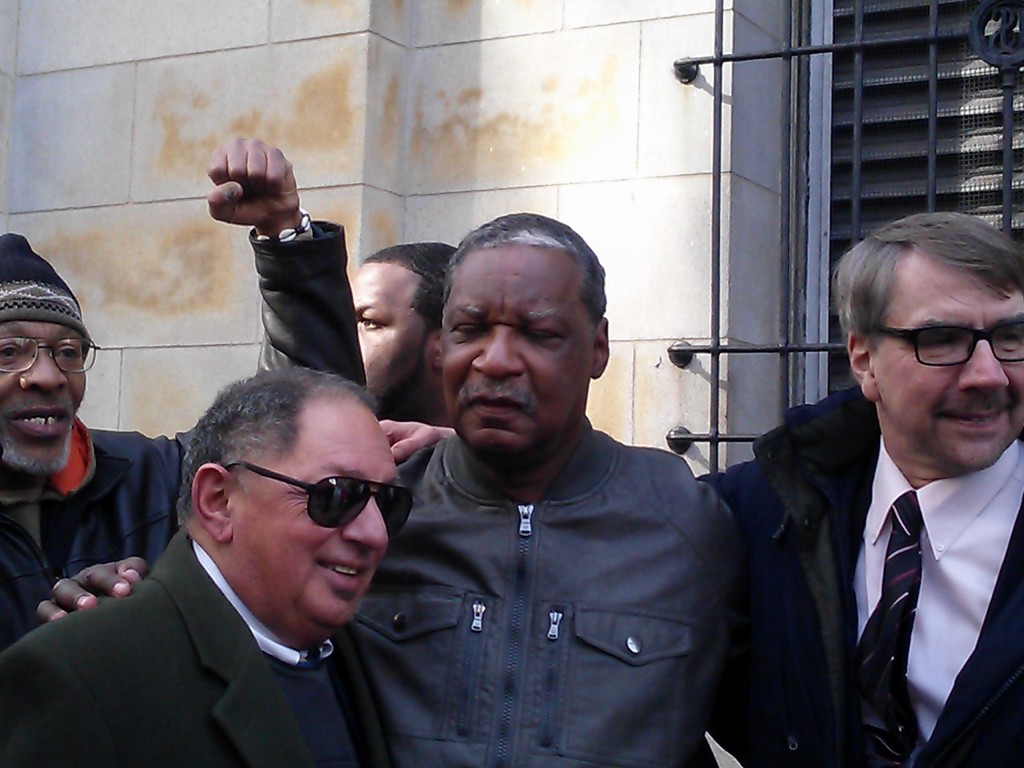
Attorney Phillip Dontes, Marshall “Eddie” Conway, Attorney Robert Boyle
On the afternoon of Tuesday, March 4, 2014, a small group of supporters gathered in a small courtroom at the CourthouseEastBuilding in downtown Baltimore, Maryland. By the time we had arrived, Effie and his attorneys were already seated at the defense table and the official pronouncement by the judge had been made. With no fanfare, Eddie was escorted from the room, still restrained in handcuffs and leg irons, and led to the Lexington Street entrance. The rest of his supporters left the building and awaited his emergence from the CourthouseEastBuilding to breathe the free air at last.
A number of his longtime supporters were there to greet him. Baba Paul Coates, who had served in the BPP with Eddie in the late 1960s, was there. Marc Steiner, who had discussed Eddie’s case on his WEAA-FM radio show several times, was there. Former Political Prisoners Laura Whitehorn and Baba Dhoriba Bin-Wahad were there. Baba Ade Oba Tokunbo, founder of the Organization of All Afrikan Unity-Black Panther Cadre, which had as one of its primary goals the freedom and exoneration of Eddie and other Political Prisoners, was there. And several others gathered on that chilly afternoon to greet Eddie back to the streets of Baltimore, a place where his example and his teachings will hopefully bring the city back to a place of wholeness and healing.
Now, however, the time has come for Eddie to enjoy the feeling of freedom. Actually, he might regard his status as being “marginally free”, or, as he had once said of those of us on the outside, “You’re not really free, you’re just loose.” In any case, it is hoped that, while a number of the local community organizations, as well as national ones such as the Jericho Organization will likely be calling him to set up appearances (the day after his release, he and Attorney Boyle appeared on DemocracyNow! for an extended interview with hosts Amy Goodman and Nermeen Shaikh), Eddie will clearly need some time to himself, to adjust to this major change in his life. “Eddie’s got that Thousand Yard Stare right now,” said veteran Panther and former Political Prisoner Dhoruba Bin-Wahad. “When he starts looking straight at you with the clear eyes, then you’ll know he’s adjusted to where he is.” We hope to see Eddie in the community soon, and we hope to be able to sit and talk with him sometime in the future. But for now, we should feel overjoyed that one battle to free a Political Prisoner has finally been won, and that those who did not live to see this day, from Safiya Bukhari and Mama Anditu Siwatu to Dr. Kwame SabakhuRa, can look down from their place among the Honored Ancestors and smile. Those of us who are still here, including Baba Ade, Nana Nyamekye, Sis. Ameejill, Bro. Hakim, Baba Dessalines, Baba Yusef and so many others who fought this long fight on the local front, can count one more freedom fighter in the Pan-Afrikan Community who was freed from the deepest, darkest corner of the Belly of the Beast. Meanwhile, Eddie has long since earned time to be with family and close friends, to fully adjust to all the technology that didn’t exist the last time he was “on the outside”, to walk through doors that will not shut and lock behind him (unless he wants them to), and to savor the smell and taste of the open air for the first time in nearly forty-four years.
Like this:
Like Loading...
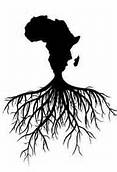 At one time in Baltimore, there was an effort to build coalitions between Pan-Afrikan organizations. The most recent one I can remember was the Tubman City Alliance, which was promoted (and possibly conceived) by activists in Reality Speaks, Solvivaz Nation and other groups.
At one time in Baltimore, there was an effort to build coalitions between Pan-Afrikan organizations. The most recent one I can remember was the Tubman City Alliance, which was promoted (and possibly conceived) by activists in Reality Speaks, Solvivaz Nation and other groups.




